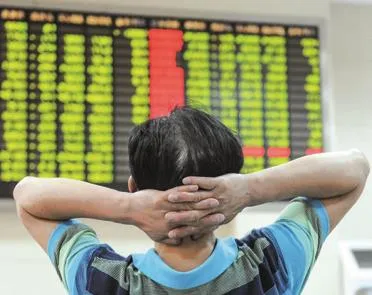Real Economy Faces Real Challenges
2012-09-12LanXinzhen
Real Economy Faces Real Challenges
Interim reports from listed companies show the Chinese economy still faces downturn pressure By Lan Xinzhen
Shanghai-listed Tianjin Quanyechang (Group) Co. Ltd. unveiled on July 11 its performance in the first half of 2012, the first listed company to do so this year. According to their commitment to the China Securities Regulatory Commission (CSRC), all 2,428 listed companies in China will publish interim reports by August 31.
By August 20, a total of 1,700 companies had released their reports. The results have been underwhelming, suggesting that China’s real economy seems to still be lingering in the shadow of the fnancial crisis.
Slower profit growth
According to the announcement by Tianjin Quanyechang, in the first half it recorded 553 million yuan ($87.09 million) of sales revenue and 4.41 million yuan ($694,488) of net profts, up by 22.62 percent and 60.38 percent, respectively, year on year. The earning per share stood at 0.01 yuan (0.16 cents). The promising outlook from the year’s beginning, however, didn’t bring too much surprise to the investors. Among the 1,700 listed companies, fewer than 600 recorded growing net profts.
In the second quarter, net profits of the 1,700 listed companies grew by only 3.8 percent over a year ago and the quarterly growth was 29 percent. In comparison, proft growth of listed companies on the quarterly basis surpassed 40 percent in the frst quarter this year and the second quarter last year, an indication that performance of listed companies is growing remarkably slowly.
In the frst half, Aluminum Corporation of China recorded the biggest losses, which stood at 3.2 billion yuan ($503.7 million).
Figures released by the National Bureau of Statistics (NBS) on August 3 also confrmed the real economy’s sluggish trend. In July, added value of industrial enterprises whose annual sales revenue is above 5 million yuan ($787,402) grew by 9.2 percent, lower than the 9.5-percent growth in June—being the lowest over the past three years. The NBS said the poor performance of heavy industries is the major reason for the slower growth of industrial added value.
Power consumption figures released by the NBS on August 14 confirmed the weak performance of heavy industries. In July, the country consumed 455.6 billion kwh of electricity, a year-on-year increase of 4.5 percent. Of the total increase, heavy industries contributed 2.4 percent, which means production was declining, industrial production capacity was not fully utilized and some enterprises had even suspended production.
According to fgures released by the China Federation of Logistics and Purchasing (CFLP) on August 1, the purchasing manager’s index stood at 50.1 percent in July, which was 0.1 percentage point lower than the previous month.
“The economy still faces downturn pressure, and government policy should focus on stabilizing economic growth based on the long-term goal of economic restructuring and transformation of the economic growth pattern,” said Cai Jin, Vice Chairman of the CFLP.
Sluggish textiles

A VEXING MARKET: An investor watches stock prices at a securities company in Hangzhou, Zhejiang Province. China's real economy is weakening the stock market due to the downturn pressure
The textile industry used to be the country’s biggest contributor to exports. In the past twodecades, exports of textiles and garments accounted for 80 percent of China’s total exports. After the global financial crisis, many textile enterprises were closed due to weak performances. There are 87 listed textile and garment enterprises in China. The published interim reports indicate that the industry’s performance has taken a hit.
Xinjiang Tianshan Wool was the frst in the textile industry to release its report. In the first half, the company suffered a loss of 15.94 million yuan ($2.51 million), almost four times the losses in the same period last year. The company said losses were mainly caused by declining international orders and growing production costs.
On August 13, the Jiangsu-based Luolai Home Textile Co. Ltd. published its interim report, saying that net profts declined by 17.7 percent in the frst half. Its own and its parent company’s inventories rose by 48.5 percent and 28.4 percent respectively.
On August 15, another Jiangsu-based textile company, Huafang Textile Co. Ltd., said its sales revenue was recorded at 733 million yuan ($115.43 million) in the frst half, a year-on-year increase of 2.28 percent. However, the operational costs were as high as 788 million yuan ($124.09 million), soaking up the net profts and making the company suffer losses of 33.76 million yuan ($5.32 million). Losses were largely due to declining prices of textiles on the international market. Since the company is located in the developed eastern region, a labor shortage has restricted its production capacity.
According to the China Cotton Textile Association, 40 percent of the cotton and textile enterprises it surveyed are suffering losses, and nearly 50 percent of the small and medium-sized spinning enterprises are reducing or stopping production.
Europe’s sovereign debt crisis is spreading and the global financial crisis is still affecting the world economy, leaving uncertainties to the prospect of the international market and depressing the confdence of Chinese textile companies seeking recovery.
“Industrial tendency in the second half is not optimistic and the growth rate will continue declining compared with the frst half,” said the announcement of Huafang Textile Co. Ltd.

Supporting policies
The real economy is fundamental to stabilizing economic growth. The most urgent for China now is to consolidate development of the real economy to overcome the crisis. Although the consumer price index grew by 1.8 percent in July, indicating that inflation is alleviated, top decision-makers have not formulated further measures to stimulate the economy.
The central bank’s hesitation in making decisions may deliver two signals to the market: Decline of the real economy at present is still acceptable; and the central bank is not yet optimistic about the price tendency in China, especially when striking price hikes of farm produce in the international market have added to infation worries of the decision-makers.
However, stabilizing growth is one of the focuses of the Central Government, and to stabilize growth, the government needs to revitalize the real economy. Liu Shangxi, Deputy Chief of the Research Institute for Fiscal Science of the Ministry of Finance, said measures of the government supporting the real economy mainly focus on upgrading and transforming the industrial structure, as well as fnancing.
Liu said there are serious problems in China’s economic structures. Under the downturn pressure, economic restructuring is accelerated and dilapidated production capacity and enterprises are being phased out, making it diffcult for enterprises to develop. Particularly, some enterprises are faced with financing difficulty and declining economic returns during the process of technology transformation. “The government should fgure out ways to combine government policies with bank credit in order to provide a good environment for enterprises. The key is to promote economic restructuring, not just preserving those dilapidated production capacities and enterprises that should have been eliminated,” Liu said.
Liu believes the government should frst carry out structural tax reduction to enterprises, reducing their burden, improving the business environment and promoting their transformation and upgrading. The government should also solve the fnancing diffculty for enterprises, especially for small and micro enterprises.
Yu Gang, Vice Chairman of the CFLP, said what enterprises look forward to most from the government is tax reduction and more financial supporting policies, so that they will have good prospects of profts and be better motivated to production.
lanxinzhen@bjreview.com
Industrial Figures In July
● Added value completed by industrial enterprises with annual sales revenue above 5 million yuan ($787,402) grew by 9.2 percent, 0.3 percentage points lower than that in June.
● Added value in state-owned and state-holding enterprises rose by 4.8 percent over a year ago, and the growth of collectively owned enterprises, joint stock enterprises and foreign-invested enterprises stood at 7.1 percent, 10.9 percent and 5.3 percent, respectively, year on year.
● Sales ratio of industrial products was 98.2 percent, a decline of 0.6 percentage points compared with the same period last year.
(Source: NBS)
